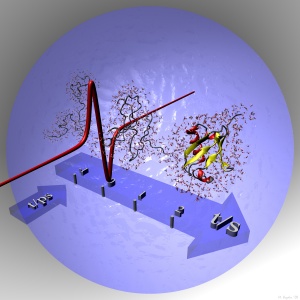Aug 5 2008
For the first time, chemists of Prof. Martina Havenith's and Prof. Martin Gruebele's group have "picturised" the spectacle of protein folding in water by THz spectroscopy. Recently, new developed KITA-spectroscopy (Kinetic Terahertz Absorption Spectroscopy) was applied to protein folding with a resolution of one picture per millisecond and combined with other biophysical methods, such as X-ray diffraction (SAXS), fluorescence and CD spectroscopy. Thereby, the researchers from the Ruhr-University Bochum and the University of Illinois observed that folding proceeds in two phases. In a very rapid first phase, the protein collapses in less than a millisecond, while at the same time, a rearrangement of the protein-water network takes place. In a slower second phase, after nearly a second, the protein folds to its native state. Hitherto, THz-spectroscopy was restricted to steady-state observations of either the start or the end point of folding. "Only now can we see the whole stage play, no longer just the opening scene and the curtain call", Prof. Havenith-Newen clarifies. This work has been published in the current edition of the journal "Angewandte Chemie".
 Cover Angewandte Chemie
Cover Angewandte Chemie
How Proteins Arrange the Water
From their previous work, the RUB-researchers already knew about the strong influence of proteins on the water in its vicinity. In the bulk, every 1.3 picoseconds hydrogen bonds are formed and broken between single water molecules – thus resulting in a fairly disorder liquid. However, even small protein concentrations bring the water molecules more in line with each other. The dynamic motions of the water network are altered by the protein. Folded proteins were also known to show a significantly different influence on water molecules than unfolded proteins. Now KITA-spectroscopy for the first time allowed insight into the time-period in-between these two states.
Dynamics of Water and Protein are Strongly Correlated
In KITA-spectroscopy, the emission of short Terahertz-pulses is used to provide unique pictures of the processes observed with millisecond-resolution. The RUB-chemists initiated the folding process and then monitored the course of events. It turned out that within less than ten milliseconds, the motions of the water network were altered as well as the protein itself being restructured. "These two processes practically take place simultaneously", Prof. Havenith-Newen states, "they are strongly correlated." These observations support the yet controversial suggestion that water plays a fundamental role in protein folding, and thus in protein function, and does not stay passive. After the initial restructuring, a second significantly slower phase (spanning a period of 0.9 seconds) takes place inside the protein. In this process, the protein folds to its final native structure.